What is the online community lifecycle?
Communities will display different behaviours at different times of their evolution. A community will go through a development journey, with activity ebbing and flowing through its growth phases.
And specific community management and community growth actions will need to be taken at different times. This is called the 'Community Lifecycle'.
An important element of community strategy is to understand, anticipate and plan for the different stages that a community will go through over the months, years, even decades of its existence.
People have life stages - childhood, adolescence, adulthood and old age - and communities are no different.
Some virtual communities are decades old and are still growing. Some communities are formed with the expectation that they will close in a matter of months once their purpose has been served. The lifecycle can be fast or slow.
In this guide, we explore what we mean by community lifecycle. We also explore the community member lifecycle.
We introduce some lifecycle models and then summarise the key strategies for community building success at every stage of your community.
Table of contents
The 5 stages of the online community lifecycle
- Acquisition Stage
- Onboarding Stage
- Engagement and Retention Stage
- Departure Stage
- Reactivation Stage
Examples of community and member lifecycle models
- The Online Community Lifecycle - Richard Millington
- The Community Lifecycle Model by Michelle Goodall
- Community Member Lifecycle by Amy Jo Kim
- Membership Life Cycle for Online Communities by Dion Hinchcliffe
- A Community Membership Life Cycle Model by Andreas C. Sonnenbichler
Drawing on other helpful models
Strategies and activities for each stage of the community lifecycle
- Phase 1: The Build
- Phase 2: Attraction
- Phase 3: Bedding In
- Phase 4: Comfortable Plateau
- Phase 5: Stick or Twist
Community lifecycle in summary
The 5 stages of the online community lifecycle
There are a couple of ways to view the community lifecycle.
The lifecycle can be time-specific stages - from when you launch to when you close your community, i.e. First 90 days, Year 1, Year 2-4, Year 4-10, Migration/Close etc.
It can also be expressed as stages that capture the movement of members into and out of your community, and the actions that should be taken at each stage.
We call this the 5 stages of the community lifecycle:
Acquisition Stage
Onboarding Stage
Engagement and Retention Stage
Departure Stage
Reactivation Stage
1. Acquisition Stage
The Acquisition Stage is where you focus on identifying potential community members and successfully invite them to join your community.
Before this phase, you will have identified a need for your community and aligned it to your business or organisational goals.
In this stage, you'll target individuals who have a need for your community. Your main objective is to raise awareness with the right people and encourage them to check out what value your community can offer to them.
You can do this in many ways - for example, by searching for people who have expressed a public interest in your topic. They may work in the sector you’re focussing on, or you may spot potential members based on what they’ve written about online, shared on social media, or said in podcasts/presentations.
Your target audience for the acquisition stage may be your existing customers, prospects, members or other people in your own network.
You can then send private or public invitations, using multiple channels including digital (e.g. email, social media direct messages etc.) and physical media (e.g. event signage, brochures, print invitations etc.).
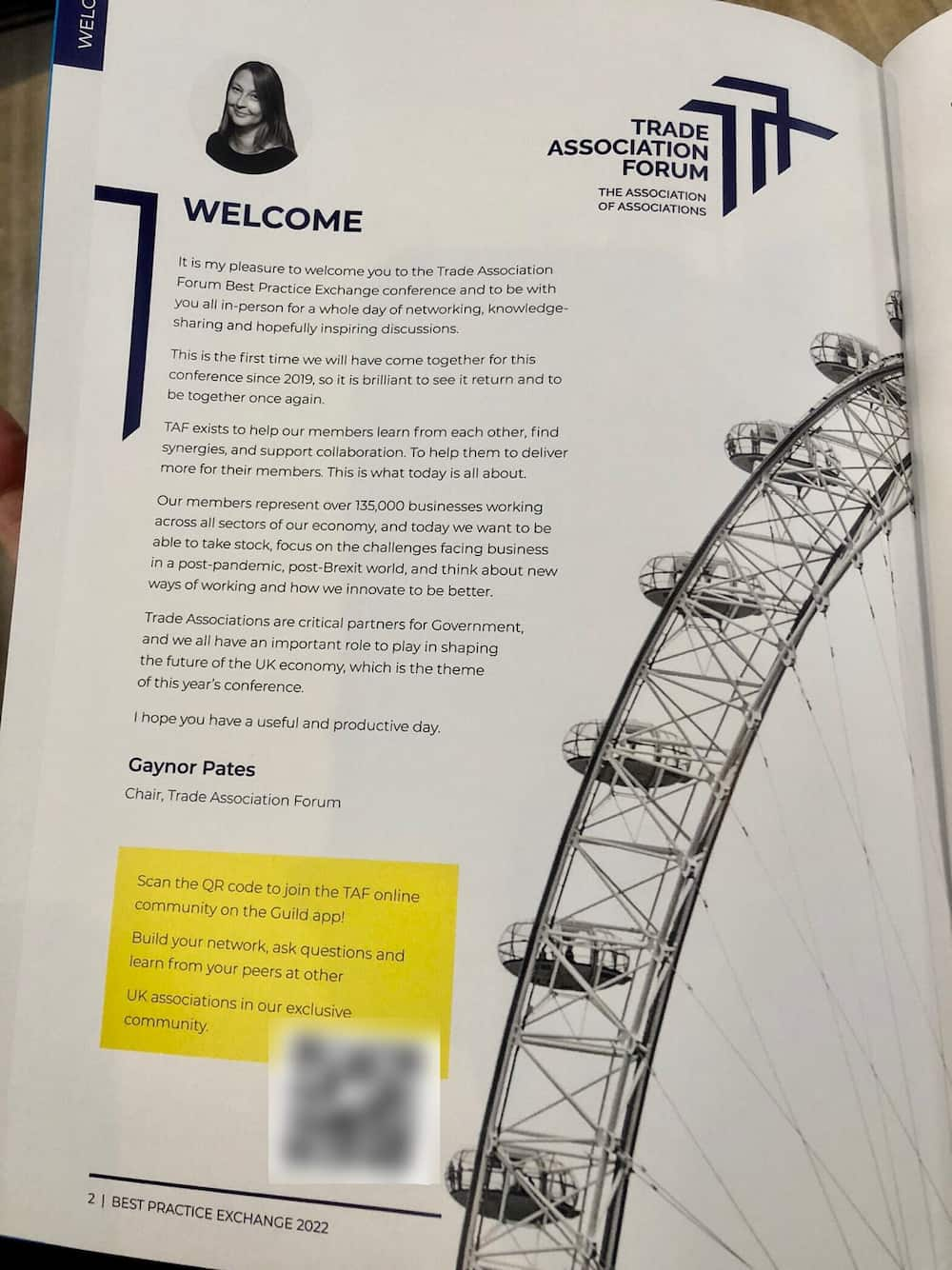
You should also share regular messaging about joining your community via your website, email and social media channels. You can advertise on search engines or targeted digital media to increase chances that the right people will see your community and join.
Ensure that your messaging clearly communicates your community's purpose and what the value will be for people who join. People will visit your community and investigate if your value proposition, messaging and content resonate with them.
Come join @blaisegv me + more #CommunityManagers and community builders for a free live Video Room meetup. Join the Community Collective and click on the video icon at 13:00 BST today https://t.co/JC7r7HCnVv #CMGR https://t.co/Y3OKNYbDVd
— Michelle Goodall (@greenwellys) September 8, 2022
You may have a landing page on your own website for people to discover your community.
You may also list your community on community directories, and if you're using Guild you can choose to make your community discoverable and use the Guild badge alongside social media icons on your website for increased visibility.
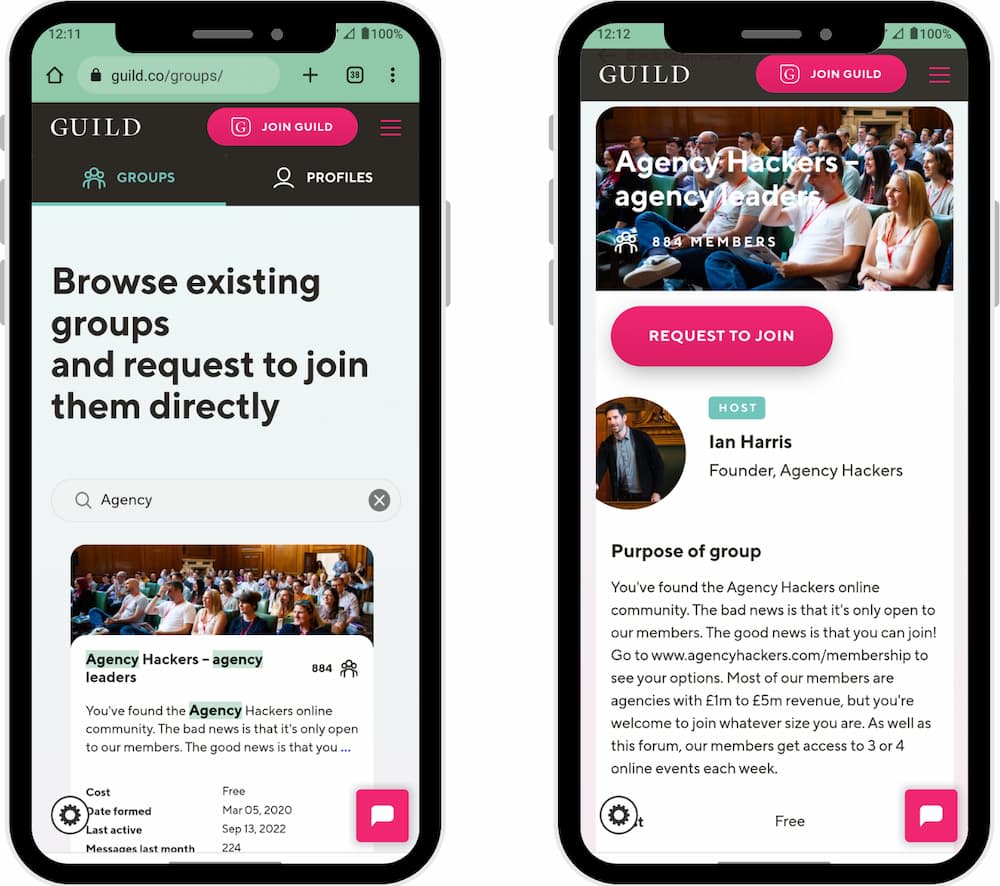
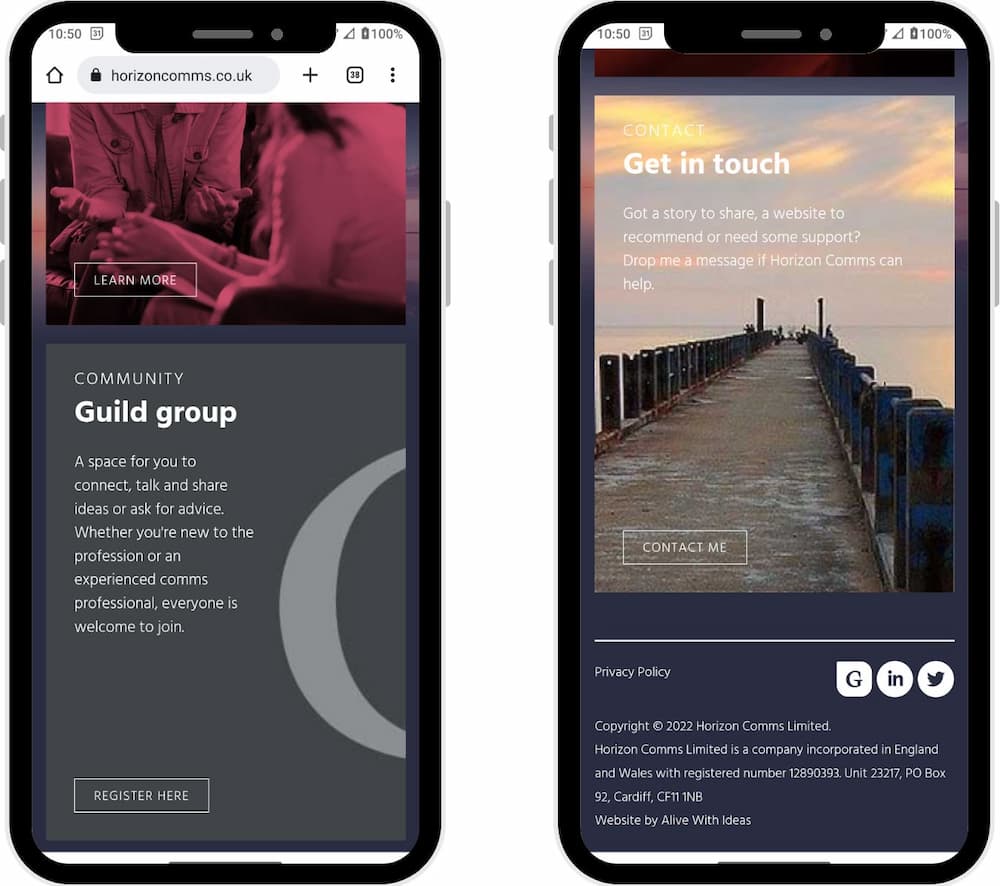
2. Onboarding Stage
The Onboarding Stage is where you focus on your community members' experience of signing up to your community.
You must consider the steps that new members need to take to ensure their journey is as smooth as possible, and that they don't fall out of the joining process.
Encourage them to engage in your community at the earliest possible by signposting what they can do and why getting involved will be of value to them.
Recommend that your community members add a profile photo and some information about themselves. You can also help them set their notifications to receive prompts to take relevant actions, such as receiving alerts for messages and conversations they're interested in. This will increase the likelihood of them coming back to the community and creates a regular habit of checking in.
Clearly display the most popular or active discussions as well as the community’s purpose. If you run challenges, ease new members into their first one and coach them to success. Have them agree to your House Rules to ensure they understand the standards and values of the community.
If your community is publicly viewable, maximise the benefits of discussions appearing in search engines by including an active prompt to sign up.
The Community onboarding stage is critical as it is the first true test of how new members perceive your community.
>>Read more - how to onboard new community members
3. Engagement & Retention Stage
At any given point, people in your community may be active posters and more passive readers or learners (never call them lurkers!).
Individuals may also be positive or negative influences on the community. These circumstances need to be covered in your planning for the Engagement & Retention stage.
The focus of this stage is to encourage the right type of engagement to ensure that your community members feel that they are in a trusted and valuable space.
At this stage, you should be starting conversations and showing approval of member-led discussions, responding to or following a conversation, sharing, bookmarking etc.
Try not to let questions in your community go unanswered if you can help, or know others who can, but equally, don't jump first on every community discussion. It's a delicate balance for community managers. Your community management toolkit needs to cater for different circumstances.
Combining discussion starters with polls is a great way to offer members additional opportunities to participate, depending on the time and effort they can give.
Over time you will want to set up a more intensive community engagement ladder, and your members can play different roles in the community. For example, you could provide motivated and active members with hosting responsibilities, more visibility and even rewards.
Allow people to spring back and forth between engagement types that work for them, so they remain active in some way.
>>Read more - ways to create engagement in your online community
4. Departure Stage
Most members of a community will leave or fade out of your community at some point.
It's inevitable because change happens! Individual interests change over time. People pass through life stages and careers, their time and availability may change, or friction in the community occurs.
It’s easy to take departures personally, but often these circumstances are beyond our control as community managers. The important aspect of the Departures Stage is understanding why people are no longer involved in your community, and making necessary changes.
You can use simple observation, surveys or emails to establish why people move away from your community. The feedback will be helpful, and former community members may go on to be ambassadors and advocates for your community, helping to fuel future growth.
Review your onboarding and calls to action if fadeouts occur early in the member lifecycle. You will be able to put in place strategies to address these exits.
If there are issues between distinct member groupings within the community, consider evolving your community strategy and consider creating sub-groups or specific events in your community, e.g. a topical livestream video meetup via Guild's Video Rooms, so that members with specific interests have somewhere relevant to get together.
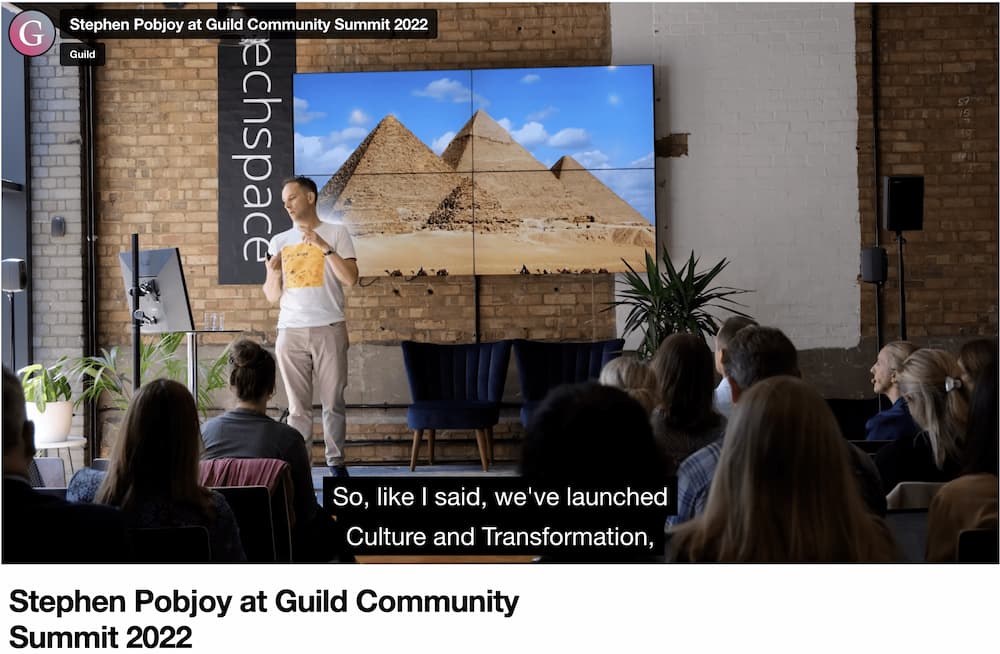
5. Reactivation Stage
If members eventually leaving the community is to be expected, it doesn’t mean they can’t be encouraged to come back someday.
By learning why someone has left your community, you can communicate particular benefits linked to that reason to try to bring them back into the fold.
Tactics from the Acquisition Stage will often work again here. Keep people informed of new features, initiatives, campaigns, content and events. It might trigger a return if they see something in the community that meets their needs.
User advocacy is often more effective than any outbound promotion. And even if someone left your community due to the personal reasons we highlighted above, such as a career or life stage change, it doesn’t mean they didn’t feel the benefits. Thanking them or giving them incentives to recommend your community to others will help them become advocates.
Whether they return or become part of your Acquisition activities, we return full circle to the beginning of this lifecycle. As long as new or past members (re)discover your community, you can keep refining your activities.
Examples of community and member lifecycle models
A number of community experts and researchers have visualised the online community lifecycle and the community member lifecycle in different models.
These models represent the stages a community goes through, from its launch to continuous renewal or closure.
Community member lifecycle models are also useful ways to understand the potential stages, journeys and experiences that individuals might have in your community.
Using these models can help community managers visualise their challenges, test ideas and formulate hypothesis to help make their communities a success.
The Online Community Lifecycle by Richard Millington, Feverbee
Richard Millington, community consultant and founder of Feverbee, presents 4 stages in his own model - Inception, Establishment, Maturity and Mitosis.
Inception is the community lifecycle stage focused on building a critical mass of members. As a community manager, you are aiming to get high levels of engagement from a relatively small number of individuals. The focus at this stage is on member acquisition, making connections and initiating and sustaining discussions.
The Establishment phase of the online community lifecycle begins when the community has reached a critical mass. At this stage, the focus is to grow your community and activity and move to a more sustainable, member-driven space. Millington suggests that the community should be generating more than 50% of growth and activity at this stage.
During the Maturity phase of the online community lifecycle, members of the community are generating 90% of the growth and activity, but there is still a limited sense of community.
Not all communities reach the Mitosis phase. This is when the community is virtually self-sustaining and continues indefinitely. At this stage, sub-groups or micro-communities might spin off from the initial communities.
The Community Lifecycle Model by Michelle Goodall
Guild CMO Michelle Goodall created a Community Lifecycle model in 2007 based on Cog’s Ladder by George Charrier, a model used to represent the formation and behaviour of groups in 1972.
Charrier's model was used to explain how working groups can become high-performing teams, and what behaviour patterns to expect throughout this process. There were five stages of group progression: the polite phase, the 'Why are we here?' phase, the Power phase, the Cooperation phase and the 'Esprit de corps' phase.
Charrier suggested teams would naturally progress through these phases, but if they were guided by a leader, they could reach the final, most productive stage more easily and quickly.
Goodall adapted this model for community managers for her community strategy lectures and used it to highlight some of the common challenges for community managers and community members at each stage.
For example, at the Polite stage, validation and permission from members is often sought and can be a barrier to participation if a community manager and members do not employ welcoming tactics and early encouragement to participate.
There could be a mismatch of expectations at the 'Why are we here? here stage. Goodall explains that members will leave when the community promise and purpose doesn't deliver for them personally or if it moves too far from its original, collective goals.
She also highlighted the challenge of noisy cliques forming and when individual members become dominant in communities at the Power stage - a potential turn-off for new members and existing members seeking an equitable space.
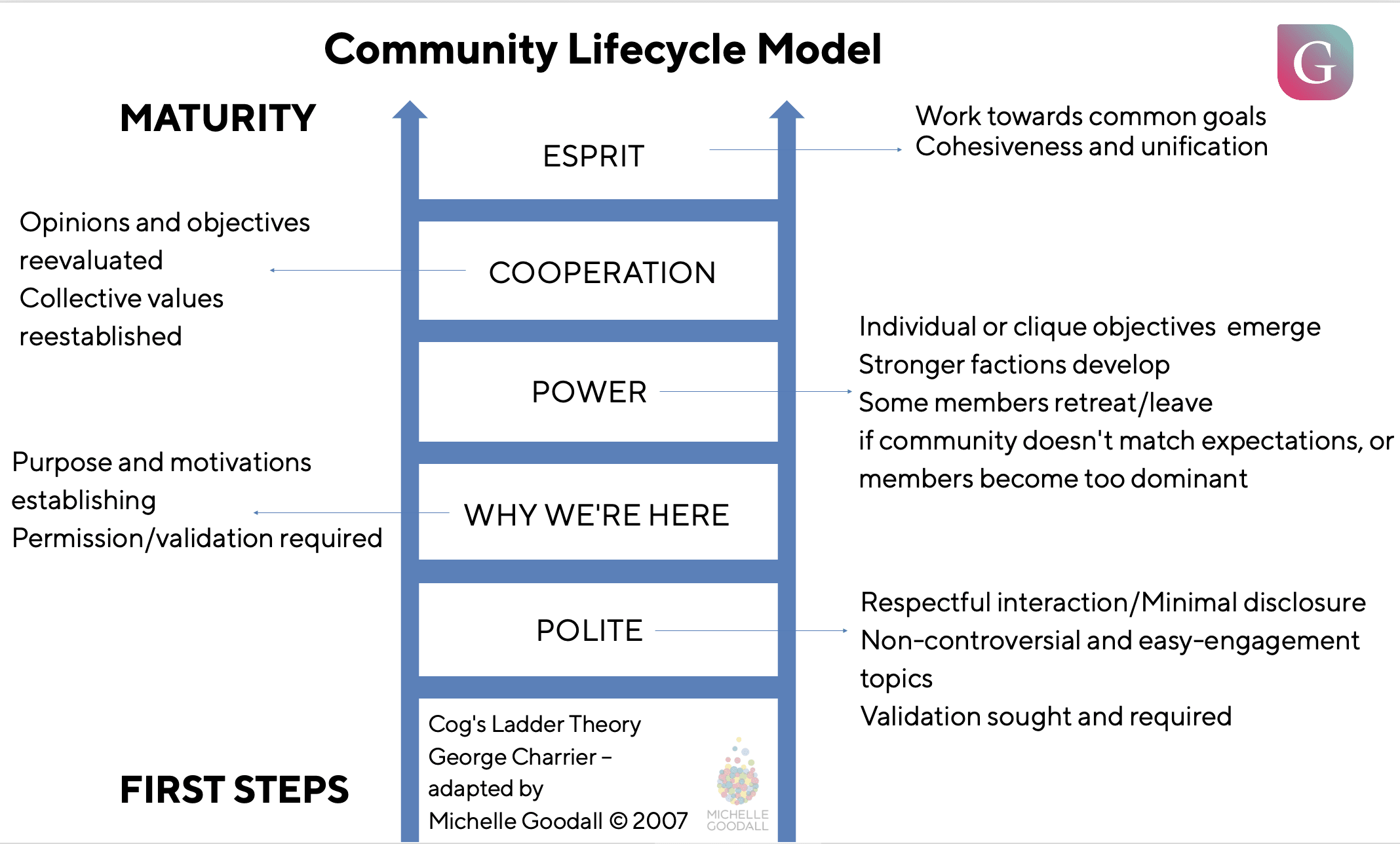
Community Member Lifecycle by Amy Jo Kim
Amy Jo Kim (Community Building on the Web, 2000) put forward the idea of a person going through a structured journey in an online community. Her model proposed five stages:
- Peripheral - an outsider or lurker, with unstructured participation
- Inbound - a new user, actively participating and growing their investment in the community
- Insider - a regular, who considers themselves a member of the community, with committed participation
- Boundary - a leader, encouraging others to take part
- Outbound - an elder, on their way out of the community due to change or personal choice
This model does not cover the discovery and attraction phase of someone finding the community. Nor does it address the reality that someone can exist at one stage based on time in the community but be exhibiting behaviours from another step.
Membership Life Cycle for Online Communities by Dion Hinchcliffe
Dion Hinchcliffe adds the discovery stage in his visual representation of the Membership Life Cycle for Online Communities in an article for ZDNet from 2008.
A Community Membership Life Cycle Model by Andreas C. Sonnenbichler
Andreas C. Sonnenbichler (A Community Membership Life Cycle Model, 2010) emphasises shifting behaviours whilst a member is active in the community.
He adds a Passive status during the Active stage to fold in phases of being an inactive member, traditionally called a lurker (here's why we don't use the term lurker on Guild).
Sonnenbichler also factors in the concept that not all Active participation is positive or constructive. The Troll status covers this. Trolls post inflammatory content with the aim of triggering emotional reactions from genuine members to disrupt the online community. This model omits the stage in which members may leave or become inactive.
Drawing on other helpful models
Community strategists and community managers can also draw inspiration from other communications and marketing models.
For example, Customer Journey Models or Maps.
Customer journey mapping is the process of understanding, visualising and improving customer experience.
It is used by many marketers to understand what actions they need to take to help customers progress easily in the customer journey towards a sale and repeated, loyal purchase (via social media, search engines, email, websites, stores, digital applications etc) and what key messages and experiences that they should be looking to deliver at each stage.
In many cases, the act of signing up to an online community isn’t a financial transaction, but the model above still has its equivalents in the community lifecycle.
A potential member will identify or be made aware of a need at the Trigger stage. They will find your community, decide whether it might address that need through viewing (Initial Brand Consideration and Active Evaluation Stages), and then join or sign up (Purchase Decision and Experience).
There will be a period of engagement (Experience and Loyalty) and at some point they may move on and leave (Out of Market). After, you will always have the opportunity to re-activate them as circumstances change (Trigger).
Strategies and activities for each stage of the community lifecycle - a summary guide
Now that we have explored various models for the community lifecycle and community member lifecycle, you will hopefully appreciate the need to apply community growth and management strategies that are relevant to the stage that your community has reached.
The initial planning and set-up process is a critical part of community success. It will include both technical aspects and policy choices, and we will cover this in other articles and guides.
The following section summarises the different activities that most experienced community strategists have applied to community programs.
It's important to note that not all communities will follow the phasing timelines below, but that they are realistic for many.
We hope that it can help you map where you are in your community lifecycle, understand what you need to broadly focus on, and discover some example tactics and potential risks you need to be aware of.
Phase 1: The Build (2-8 weeks depending on community platform)
What it looks like:
The Build phase involves planning and setup to have your community ready for the public. It's important to identify goals and measurements along with any policies that are foundational to the community.
Broad strategy:
Put in place all infrastructural mechanics that support the existence of your community.
Typical activities:
- Create an internal team who are responsible for running and leading the community
- Identify and set up the technology that will power your community space. This would include branding, workflows and integrations with your other platforms
- Agree processes for community management and moderation. Set your content plan, engagement plan and moderation policies
- Document your community purpose, guidelines and house rules
- Invite a test group to trial your community
Risks:
Any gaps or oversights will become clear as the community develops. Testing rounds are useful to identify these and fix them before going live.
Phase 2: Attraction (1-6 months depending on the existence of an existing pool of potential members)
What it looks like:
The Attraction phase is when we start inviting people to join the community. We’ll onboard them, begin interacting with them and activate our content and engagement plan.
Broad strategy:
Reach a depth of organic engagement between community members without our regular input.
Typical activities:
- Create content and experiences within the community to stimulate engagement.
- Set the tone of what contributions are appropriate and use active listening, e.g. applause, asking further questions etc.
- Promote the community through existing communication and marketing channels
- Invite people from your networks that are likely to want to take part in your community. These might come from your organisation's existing customer or prospect database, social networks, in-person events/meetups etc.
- Nurture each new member by encouraging them to respond and start their own discussions
- Introduce community members to one another to begin building bonds
- Seek feedback on various aspects of the community space to allow you to fine-tune as you go
Risks:
New members might not feel comfortable engaging without enticing content or the positive prompt of others responding.
People feel more comfortable jumping into active discussions. Attracting the wrong kind of member with mismatched interests can also negatively impact trust and participation.
Phase 3: Bedding In (4-12 months depending community)
What it looks like:
By this point, you’ll have a pool of regular member contributors. New members regularly joining, and your community will have good visibility. Your need to contribute as a host, community manager or moderator will be lower.
Broad strategy:
Establish processes to scale member acquisition, encourage high levels of community engagement, participation and achieve your community goals/objectives.
Typical activities:
- Organise community content to make it more findable
- Promote social proof examples from within the community to increase trust
- Create community rituals - regular, recurring, anticipated prompts in your community that make members feel connected and encourage a sense of belonging
- Provide a platform for members to be recognised by running member events such as AMAs, video livestreaming, interviews and member spotlights
- Focus your content creation on high-value activities that strengthen culture and bonds in your community
- Facilitate super user panels or volunteers to help run the community
Risks:
The volume of content may reach a point where it feels overwhelming for new members.
Help them identify what is valuable when onboarding them. Cliques may form and some members might dominate discussions and turn off other community members. If bad behaviour becomes routine, a lack of community management processes will allow it to become systemic.
Phase 4: Comfortable Plateau (2-4 years depending on sense of belonging)
What it looks like:
There is a shared sense of culture and belonging in the community. The volume of data on conversational topics and member activity is high. Members drive most activities. There may be a flattening or decrease in new members.
Broad strategy:
Create a personalised experience for members and collaborate with them on broad ideas. Continue to achieve your community goals/objectives.
Typical activities:
- Ensure relevant content to each member is shown to them via personal dashboards or notification centres
- Consolidate your community market position by promoting case studies and successes - you can do this both internally and in the media
- Take part in awards schemes and communicate success to the community
- Establish a mentorship program to retain long-standing members
Risks:
The community can feel stagnant without fresh ideas, even if it has a strong purpose. You must put initiatives in place to match these changes. The aim is to avoid losing members and their contributions.
Phase 5: Stick or Twist (3-5 years depending on how strong the sense of community is)
What it looks like:
Groups of members drift to tight-knit spaces as the community is so large. Contributions decrease as most topics have been covered.
Broad strategy:
Empower sub-groups to split off and develop smaller communities with their own growth plans. Consider refreshing and rebranding - potentially even a change in purpose.
Typical activities:
- Create or allow super users or volunteers to set up new community spaces focused on sub-topics of interest
- Provide training and guidance to hosts of these communities - this will help them develop engagement and attract new members
- Update and refresh old content to remain relevant and in line with current informational needs
Risks:
Connectedness between groups could fray, leading to continual decline.
New members may find the core community lacking excitement or opportunities for participation. Sub-groups decide to leave altogether for other platforms that better serve their needs.
Community lifecycle in summary
Building a successful, mature community can take months and years. It's a lot like building a brand.
Recognising which phase your community is in and matching the right growth activities is critical.
It's also crucial to continuously observe how members engage, and understand what creates a strong sense of belonging over time and what helps you reach your goals.
Having the space to adjust your approach, and having the support to do it is vital to this process.
More community strategy training
Community Strategy and Community Management resources hub
What are the different types of online community? The 5Ps of community.
The Periodic Table of Community Strategy
How to align Community to your organisation or business goals
Discuss the community lifecycle and member lifecycle with community professionals
Guild Community Collective is a community for anyone interested in sharing best practice, ideas, inspiration, interesting content and resources, or getting feedback on community ideas and initiatives.
Community and social media managers, builders, strategists are all welcome - regardless of experience levels. Join today to ask your questions or seek support or partnerships on identifying and maximising your community's own lifecycle.

About the author

Blaise Grimes-Viort has 20+ years of Social Media & Online Community Management experience. He has built and managed large teams of moderators, social media & community managers and volunteer community leaders.
A hands-on community manager and host of Guild Community Collective - the community for community and social media professionals.
Blaise has a track record of success building communities, both online and offline, in Publishing, Telecoms, Entertainment, Auto, Financial, FMCG, Charity, Gaming and more.
You can connect with Blaise on Guild.
Join Guild 🤝
See for yourself how the Guild experience is different to WhatsApp, Slack, LinkedIn or Facebook Groups.
Guild is a safe space to connect, communicate and collaborate with others.
Join us on a platform that is purpose-built for creating groups, communities and networks on mobile.